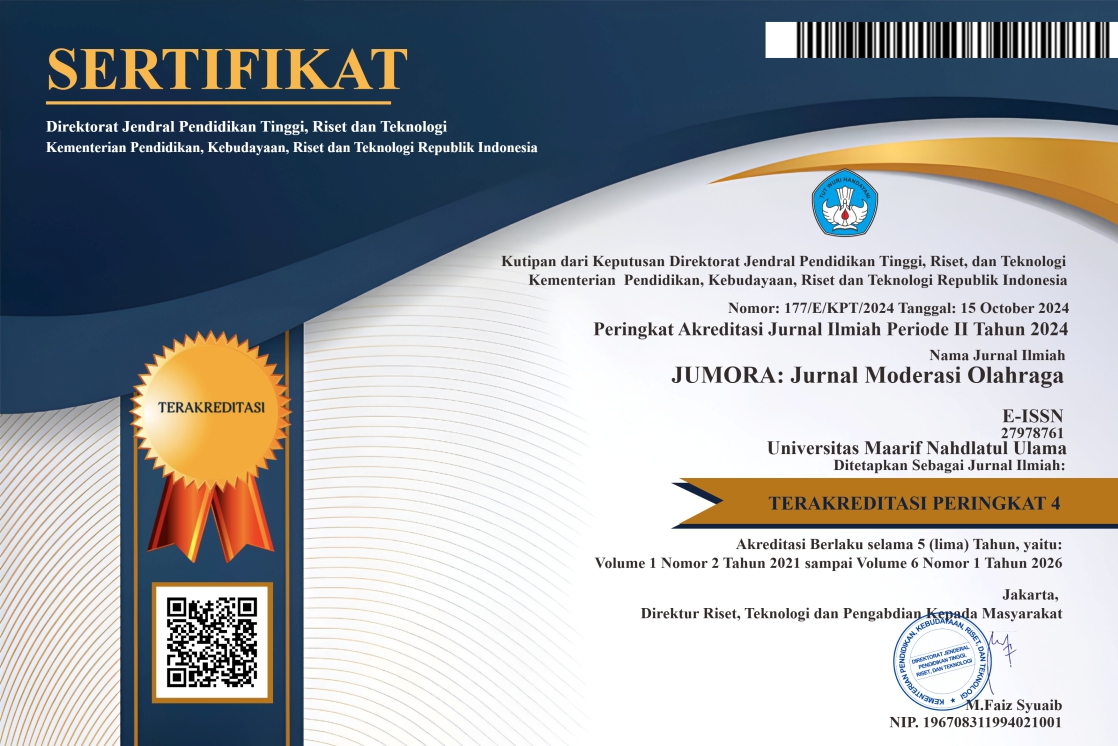The Effectiveness of Flipbook Learning in Sports Physiology Courses Improves Student Achievement In the course of the Pandemic
DOI:
https://doi.org/10.53863/mor.v2i1.411Keywords:
flipbook, physiology of sports, motivation to learnAbstract
This study aims to provide an overview of the persuasiveness of flipbooks and education in the COVID 19 pandemic, an Omicron variant of the sports physiology course. The study is a descriptive quantitative study that evaluates educational flipbooks in a course of exercise physiology. The subjects of the study are the second semester of the 2020 class students who are taught in the exercise physiology course using virtual flipbooks. The study sample is the second semester of 2020 undergraduates whose location was selected using a simple random sampling technique, taking into account population uniformity. I will go to collect musical instruments in the flip book learning questionnaire. Engagement analysis used descriptive statistics. Consequence showed so students assessed that learning sports physiology apply flipbooks was effective (23.3%), rated it as productive (46.7%), along time placed average (20%). Handful students think about online education flipbooks failed (10%) and totally none (0%) who rate it very inefficient. Finally, to better the quality of flipbook learning in sports physiology in the course of the omicron variant of covid19 pandemic, schoolteacher must realize suggestions from respondents, namely: (1) studying is execute through video calls; (2) equipping of concise study materials; (3) minimizing dispatch material in the form of heavy videos to save quota with flipbook application; (4) the selection material flipbook on the criteria of language easy to understand; (5) continue lay out material before assignment; (6) display varied and contrasting questions for each student; (7) occupation include how it works; (8) assign occupation according course schedule; (9) prompt students an occupation given, with (10) reduce the task.
Keywords: Abstract in English about 3-6 words, sorted alphabetically
References
REFERENCES
Altura, G. J., & Curwood, J. S. (2015). Hitting restart: Learning and gaming in an Australian classroom. Journal of Adolescent and Adult Literacy, 59(1), 25–27. https://doi.org/10.1002/jaal.438
Arifin, S., Ardiyansah, B., Budi, I., Malang, U., Citandui, J., & Malang, K. (2017). Penerapan Media Karikatur Berbasis Sparkol Video Scribe untuk Meningkatkan Hasil Belajar Kognitif pada Matakuliah Genetika Mahamahasiswa, 2(2), 18–25
Arikunto, Suharsimi. 2010. Prosedur Penelitian Suatu pendekatan Praktek. Jakarta: Rineka Cipta
Baharin, N., Kamarudin, N., &Manaf, U. K. A. (2018).Integrating STEM education approach in enhancing higher order thinking skills. International Journal of Academic Research in Business and Social Sciences, 8(7), 810–821. https://doi.org/10.6007/ijarbss/v8-i7/4421
Einum, E. (2020). Involvement with response technology as student-centring of language teaching: Upper-secondary student and teacher experiences. Nordic Journal of Digital Literacy, 14(1–2), 6–22. https://doi.org/10.18261/ISSN.1891-943X-2019-01-02-02
E R Wardani, Mardiyana, D R S Saputro. "Online Mathematics Learning during the Covid-19 Pandemic", Journal of Physics: Conference Series, 2021, DOI:10.1088/1742-6596/1808/1/012044
Karhiwikarta, W.1978. Ilmu Faal Olahraga.Bandung : Lab Ilmu Faal Fakultas Kedokteran Umum Universitas Padjajaran
Mayer, R. E. (2005). The Cambridge handbook of multimedia learning. Cambridge university press. Retrieved from https://books.google.co.id/books?hl=id&lr=&id=SSLdo1MLIywC&oi=fnd&pg=PR9&dq=%5B4%5D+Mish+Sanjaya,+and+R.C.+Sha%5B5%5D%09RE.+Mayer.+The+Cambridge+handbook+of+multimedia+learning+Cambridge+university+press, +2005.rma.+Interactive+multimedia+in+education
M. Noer, Hypnoteaching for Success Learning. Yogyakarta: PustakaInsani, 2010
Nurseto, T. 2011. Membuat Media Pembelajaran yang Menarik.JurnalEkonomidanPendidikan. Vol. 8(1):19-35
P. D. Ansari and P. D. Malik, “Image of an Effective Teacher in 21 st Century Classroom,” J. Educ. Instr. Stud., pp. 61–64, 2013
Priatmoko, S., Saptorini, danDiniy, H. H. 2012.Penggunaan Media SirkuitCerdikBerbasis Chemo EdutaimentdalamPembelajaranLarutanAsamBasa. JurnalPendidikanIPA Indonesia. Vol 1(1): 37-42
Purwanto. (2008). Evaluasi Hasil Belajar. Bandung: Pustaka Pelajar
Ratno Susanto and Riyanto. 2019. Students’ Critical Thinking Ability in Tennis Mathematics of Physical Health Education and Recreation. International Journal of Scientific and Research Publications. Volume 9, Issue 9, September. ISSN 2250-3153. DOI: 10.29322/IJSRP.9.09.2019.p9371, http://dx.doi.org/10.29322/IJSRP.9.09.2019.p9371
Ratno Susanto and Endang Sri Lestrai. 2020. THE EFFECT OF FLIPBOOK-BASED FIELD TEACHING MATERIALS WITH ANCHORED INSTRUCTION MODEL TO IMPROVE STUDENTS' CRITICAL THINKING SKILLS. European Journal of Education Studies.Volume 7 ? Issue 12 ? 2020.ISSN 2501- 1111. DOI: 10.46827/ejes.v7i12.3475. Available on-line at: www.oapub.org/edu
Riyanto, R., Amin, M., Suwono, H., & Lestari, U. (2020). The New Face of Digital Books in Genetic Learning: A Preliminary Development Study for Students’ Critical Thinking. International Journal of Emerging Technologies in Learning (IJET), 15(10), 175. https://doi.org/10.3991/ijet.v15i10.14321
Ruslan, Rosady. 2003. Metode Penelitian PR dan Komunikasi. Jakarata : PT. Raja Grafindo Persada
Rudi Susilana.Cepi Riyana,.2008.Media Pembelajaran. Bandung :CV Wacana Prima
Susanto, R., &Riyanto, R. (2020). Development of Teaching Material of Sony Vegas Media Based with Anchored Instruction Models for Tennis Course in IKIP Budi Utomo Malang. In Proceeding International Conference on Science and Engineering (Vol. 3, pp. 623–627)
Sugiyono. 2010. Metode Penelitian Pendidikan Pendekatan Kuantitatif, kualitatif, dan R&D. Bandung: Alfabeta
Downloads
Published
How to Cite
Issue
Section
License
Copyright (c) 2022 Ratno Susanto;Achmad Afandi,Farizha Irmawati

This work is licensed under a Creative Commons Attribution-ShareAlike 4.0 International License.
Authors retain copyright and grant the journal right of first publication with the work simultaneously licensed under a Creative Commons Attribution-ShareAlike 4.0 International License that allows others to share the work with an acknowledgment of the work’s authorship and initial publication in this journal












